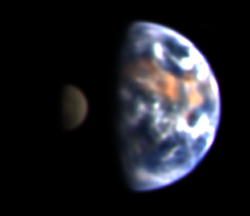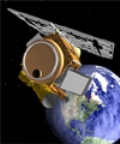EPOXI
Two intriguing investigations -- One flight-proven spacecraft
News: UM-Led Deep Impact Films Earth as Alien World, 2008.07.17
Press Release
UM-Led Deep Impact Films Earth as Alien World2008.07.17
COLLEGE PARK, Md. -- As part of its new mission, the Deep Impact spacecraft has created a video of the moon passing in front of Earth as seen from the spacecraft's point of view 31 million miles away. Scientists involved in the University of Maryland-led mission are using the video to develop techniques to study alien worlds.
"Making a video of Earth from so far away helps the search for other life-bearing planets in the Universe by giving insights into how a distant, Earth-like alien world would appear to us," said University of Maryland astronomer Michael A'Hearn, principal investigator for the Deep Impact extended mission called EPOXI.
On July 4 2005, NASA's original Deep Impact mission, also led by the University of Maryland, made history and world-wide headlines, when it smashed a probe from the spacecraft into comet Tempel 1. Following the conclusion of that mission, a Maryland-led team of scientists won approval from NASA to fly the Deep Impact spacecraft to Comet Hartley 2 on a two-part extended mission known as EPOXI.
The name EPOXI is a combination of EPOCh and DIXI, the acronyms for the two components of the extended mission. The Extrasolar Planet Observations and Characterization or EPOCh component is a search for search for Earth-like planets around stars selected as likely candidates for such planets. EPOCh observations began in January 2008. The Deep Impact eXtended Investigation or DIXI is the cometary investigation portion of the mission, with an expected Hartley 2 flyby date of Nov. 4, 2010.
The Earth, the Moon, the Movie
During a full Earth rotation, images obtained by the Deep Impact spacecraft have been combined to make a color video. During the video, the moon enters the frame (because of its orbital motion) and transits Earth, then leaves the frame. Other spacecraft have imaged Earth and the moon from space, but Deep Impact is the first to show a transit of Earth with enough detail to see large craters on the moon and oceans and continents on Earth.
"To image Earth in a similar fashion, an alien civilization would need technology far beyond what Earthlings can even dream of building," said Sara Seager, a planetary theorist at the Massachusetts Institute of Technology, Cambridge, Mass., and a co-investigator on EPOXI. "Nevertheless, planet-characterizing space telescopes under study by NASA would be able to observe an Earth twin as a single point of light -- a point whose total brightness changes with time as different land masses and oceans rotate in and out of view. The video will help us connect a varying point of planetary light with underlying oceans, continents, and clouds -- and finding oceans on extrasolar planets means identifying potentially habitable worlds." said Seager.
"Our video shows some specific features that are important for observations of Earth-like planets orbiting other stars," said Drake Deming of NASA's Goddard Space Flight Center in Greenbelt, Md. Deming is deputy principal investigator for EPOXI, and leads the EPOCh observations. "A 'sun glint' can be seen in the movie, caused by light reflected from Earth's oceans, and similar glints to be observed from extrasolar planets could indicate alien oceans. Also, we used infrared light instead of the normal red light to make the color composite images, and that makes the land masses much more visible." That happens because plants reflect more strongly in the near-infrared, Deming explained. Hence the video illustrates the potential for detecting vegetated land masses on extrasolar planets by looking for variations in the intensity of their near-infrared light as the planet rotates.
The University of Maryland is the Principal Investigator institution, leading the overall EPOXI mission, including the flyby of comet Hartley 2. NASA Goddard leads the extrasolar planet observations. NASA's Jet Propulsion Laboratory, Pasadena, Calif., manages EPOXI for NASA's Science Mission Directorate, Washington. The spacecraft was built for NASA by Ball Aerospace & Technologies Corp., Boulder, Colo.
Lee Tune
University of Maryland, College Park
301.405.4679
ltune [at] umd [dot] edu
Nancy Neal-Jones / Bill Steigerwald
NASA Goddard Space Flight Center, Greenbelt, Md.
301.286.0039 / 5017
Nancy.N.Jones [at] nasa [dot] gov / william.a.steigerwald [at] nasa [dot] gov
DC Agle / Carolina Martinez
Jet Propulsion Laboratory, Pasadena, Calif.
818.393.9011 / 818.354.9382
agle [at] jpl [dot] nasa [dot] gov / Carolina.Martinez [at] jpl [dot] nasa [dot] gov
David L. Chandler
Massachusetts Institute of Technology, Cambridge, Mass.
617.253.2704
dlcl [at] mit [dot] edu
RELEASE: 08118, Source

 Click for access to multiple formats.
Click for access to multiple formats.